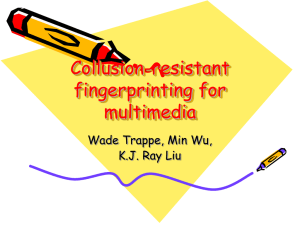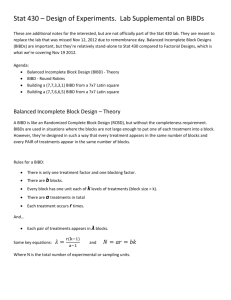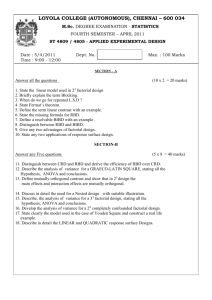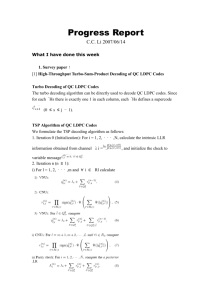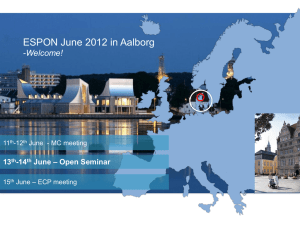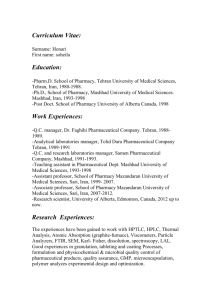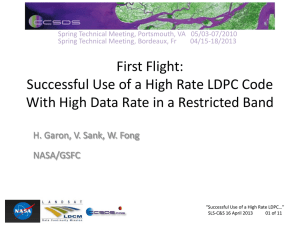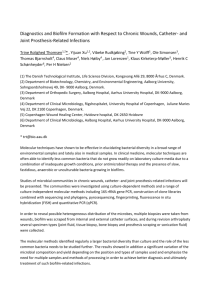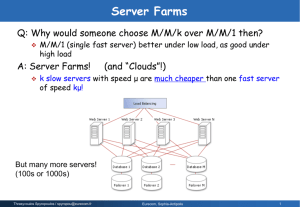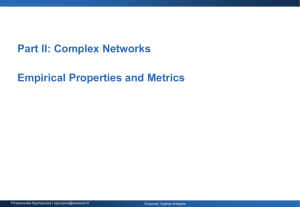Call
advertisement
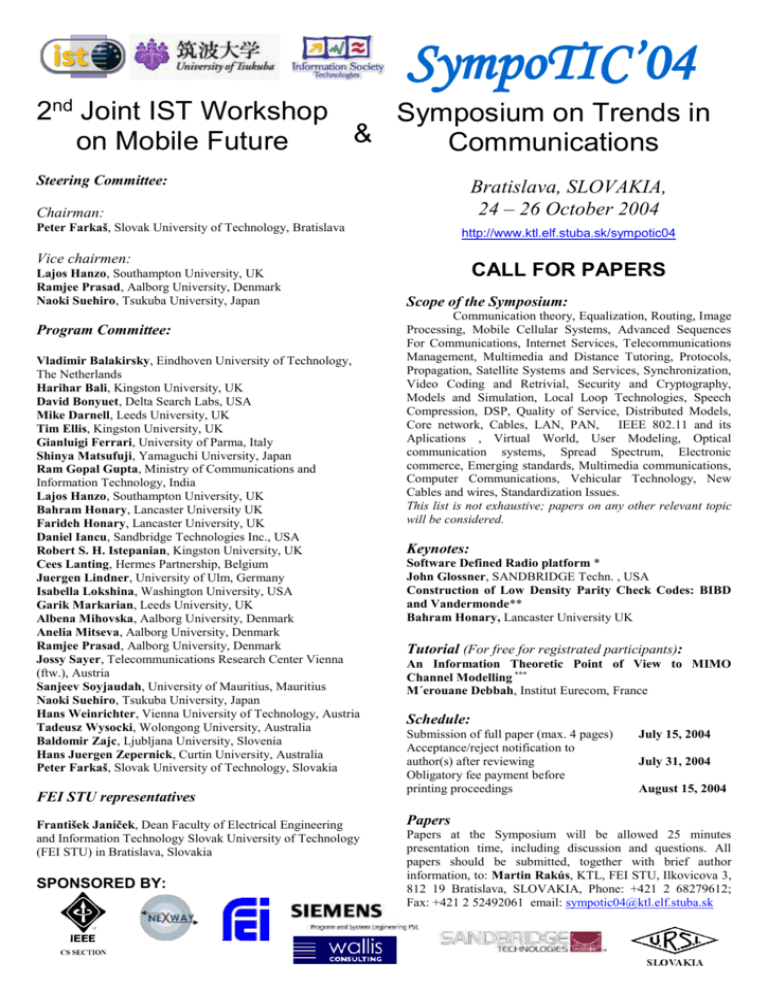
SympoTIC’04 2nd Joint IST Workshop Symposium on Trends in & on Mobile Future Communications Steering Committee: Bratislava, SLOVAKIA, 24 – 26 October 2004 Chairman: Peter Farkaš, Slovak University of Technology, Bratislava http://www.ktl.elf.stuba.sk/sympotic04 Vice chairmen: Lajos Hanzo, Southampton University, UK Ramjee Prasad, Aalborg University, Denmark Naoki Suehiro, Tsukuba University, Japan Program Committee: Vladimir Balakirsky, Eindhoven University of Technology, The Netherlands Harihar Bali, Kingston University, UK David Bonyuet, Delta Search Labs, USA Mike Darnell, Leeds University, UK Tim Ellis, Kingston University, UK Gianluigi Ferrari, University of Parma, Italy Shinya Matsufuji, Yamaguchi University, Japan Ram Gopal Gupta, Ministry of Communications and Information Technology, India Lajos Hanzo, Southampton University, UK Bahram Honary, Lancaster University UK Farideh Honary, Lancaster University, UK Daniel Iancu, Sandbridge Technologies Inc., USA Robert S. H. Istepanian, Kingston University, UK Cees Lanting, Hermes Partnership, Belgium Juergen Lindner, University of Ulm, Germany Isabella Lokshina, Washington University, USA Garik Markarian, Leeds University, UK Albena Mihovska, Aalborg University, Denmark Anelia Mitseva, Aalborg University, Denmark Ramjee Prasad, Aalborg University, Denmark Jossy Sayer, Telecommunications Research Center Vienna (ftw.), Austria Sanjeev Soyjaudah, University of Mauritius, Mauritius Naoki Suehiro, Tsukuba University, Japan Hans Weinrichter, Vienna University of Technology, Austria Tadeusz Wysocki, Wolongong University, Australia Baldomir Zajc, Ljubljana University, Slovenia Hans Juergen Zepernick, Curtin University, Australia Peter Farkaš, Slovak University of Technology, Slovakia FEI STU representatives František Janíček, Dean Faculty of Electrical Engineering and Information Technology Slovak University of Technology (FEI STU) in Bratislava, Slovakia SPONSORED BY: CALL FOR PAPERS Scope of the Symposium: Communication theory, Equalization, Routing, Image Processing, Mobile Cellular Systems, Advanced Sequences For Communications, Internet Services, Telecommunications Management, Multimedia and Distance Tutoring, Protocols, Propagation, Satellite Systems and Services, Synchronization, Video Coding and Retrivial, Security and Cryptography, Models and Simulation, Local Loop Technologies, Speech Compression, DSP, Quality of Service, Distributed Models, Core network, Cables, LAN, PAN, IEEE 802.11 and its Aplications , Virtual World, User Modeling, Optical communication systems, Spread Spectrum, Electronic commerce, Emerging standards, Multimedia communications, Computer Communications, Vehicular Technology, New Cables and wires, Standardization Issues. This list is not exhaustive; papers on any other relevant topic will be considered. Keynotes: Software Defined Radio platform * John Glossner, SANDBRIDGE Techn. , USA Construction of Low Density Parity Check Codes: BIBD and Vandermonde** Bahram Honary, Lancaster University UK Tutorial (For free for registrated participants): An Information Theoretic Point of View to MIMO Channel Modelling *** M´erouane Debbah, Institut Eurecom, France Schedule: Submission of full paper (max. 4 pages) Acceptance/reject notification to author(s) after reviewing Obligatory fee payment before printing proceedings July 15, 2004 July 31, 2004 August 15, 2004 Papers Papers at the Symposium will be allowed 25 minutes presentation time, including discussion and questions. All papers should be submitted, together with brief author information, to: Martin Rakús, KTL, FEI STU, Ilkovicova 3, 812 19 Bratislava, SLOVAKIA, Phone: +421 2 68279612; Fax: +421 2 52492061 email: sympotic04@ktl.elf.stuba.sk * Keynote: Software Defined Radio platform Abstract: Sandbridge Technologies has developed a Software Defined Radio platform for executing Communications and Applications algorithms in software. The platform consists of parallel multithreaded processors capable of executing DSP, Java, and RISC control code in a unified Instruction Set Architecture (ISA). Combined with a sophisticated vectorizing, parallelizing, and automatically multithreading compiler, optimized code is produced for the platform from an ANSI-C specification. In this talk, we describe the implementation of a number of communications systems and present performance results for WCDMA, 802.11b, GSM/GPRS, and GPS systems. Biography: Dr. John Glossner is CTO & EVP of Engineering at Sandbridge Technologies. Prior to co-founding Sandbridge, John managed the Advanced DSP Technology group, Broadband Transmission Systems group, and was Access Aggregation Business Development manager at IBM’s T.J. Watson Research Center. Prior to IBM, John managed the software effort in Lucent/Motorola’s Starcore DSP design center. John received a Ph.D. in Computer Architecture from TU Delft in the Netherlands for his work on a Multithreaded Java processor with DSP capability. He also received an M.S. degree in Engineering Management and an M.S.E.E. from NTU. John holds a B.S.E.E. degree from Penn State. John has more than 40 publications and 12 issued patents. ** Keynote: Construction of Low Density Parity Check Codes: BIBD and Vandermonde Bassem Ammar, Bahram Honary Abstract: In this presentation we shall go briefly through the properties of LDPC-codes and discuss two methods for constructing LDPC matrices. One of these methods is based on BIBD, which we explain in the first part of the presentation. We shall go through the definition of BIBD and introduce the general methods of finding them. Then we shall explain one particular method called symmetrically repeated differences SRD and explain several designs based on this method. We shall then show how to use BIBD in LDPC construction. Go through the performance of some LDPC-codes based on BIBD [1, 2]. The second part of the presentation introduces a simple method to construct quasi-cyclic LDPC codes. It is based on Vandermonde matrix [4] and we compare it with BIBD method [3]. [1] Ammar, B., Lin, S., Honary, B. and Kou, Y. (2002) “Construction of Low Density Parity Check Codes: A Combinatoric Design Approach,” Information Theory, 2002. Proceedings. 2002 IEEE International Symposium on , 2002 Page: 311 –311. [2] Ammar, B., Honary, B., Kou, Y., Xu, J. and Lin, S., (2004) “Construction of Low Density Parity Check Codes based on balanced incomplete block designs,” IEEE Transactions on Information Theory, June-2004. [3] Gabidulin, E., Ammar, B., Honary, B. (2004) “Simple method for constructing quasi-cyclic regular LDPC codes” 9th International Workshop on Algebraic and Combinatorial Coding Theory, ACCT 2004. [4] Yang, K. and Helleseth, T.,(2003) “On the minimum distance of Array codes as LDPC Codes”, IEEE Trans. on Inform. Theory, vol 49, pp. 3268-3271, Dec. 2003. *** Tutorial: An Information Theoretic Point of View to MIMO Channel Modelling, Merouane Deborah, Eurecom, Franc M´erouane Debbah Institut Eurecom, Mobile Communications Group 2229 Route des Cretes, B.P. 193, 06904 SOPHIA ANTIPOLIS CEDEX France http://www.eurecom.fr/~debbah Abstract: The tutorial presents an in-depth introduction to recent results on MIMO channel modelling. A unifying approach, based on the principle of Maximum Entropy, is provided to construct consistent models: the consistency argument is at the heart of scientific inference and gives an explicit answer to the problem posed by the striking number of papers dedicated to MIMO channel models1. Indeed, nearly all the models proposed are different and moreover validated by measurement campaigns! Who should we trust? This tutorial aims at providing some partial answers to this question by combining the influence of two fields namely Communication theory and Bayesian probability theory. Moreover, for each channel model, an asymptotic analysis (in the number of antennas) of the achievable transmission rate is conducted using tools of random matrix theory and central limit theorems are provided on the asymptotic behavior of the mutual information. The results give means to design services based on criteria such as quality of service or to derive useful metrics for channel measurements. At the final stage of the tutorial, discussions on measurements performed in Oslo at 2.1 GHz and 5.2 GHz and their interactions with the models proposed are given.
